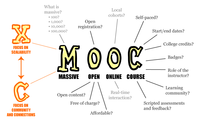
Photo from wikipedia
Over the years, a body of studies on online learning has documented low completion rates in MOOCs among learners, an educational challenge that has created the phenomenon “funnel participation”. This… Click to show full abstract
Over the years, a body of studies on online learning has documented low completion rates in MOOCs among learners, an educational challenge that has created the phenomenon “funnel participation”. This educational challenge refers to that thousands of online learners register but only small groups complete MOOCs they signed up for. Normally, persons who complete online courses have a demographic background, ambitious males in their 30s with a master-degree working in IT or business and management. Such factors raise concern among researchers about the overall quality of MOOCs and how they are designed to foster engaging learning experiences. Recent research concludes that the instructional quality of MOOCs is low and that MOOC designers need to re-think how they create future online learning experiences. In light of this matter, this working paper forwards a conceptual approach on how online course designers can use storytelling and scriptwriting as pedagogical strategies to enhance the instructional quality of MOOCs. This subject matter is exemplified by outlining the course design of a MOOC aimed at preparing teachers to use digital technologies in a classroom setting. The learning material of the MOOC is research based and builds on a field study that explored how a teacher used digital technologies in foreign language training at a Norwegian high school.
Journal Title: European Journal of Education
Year Published: 2019
Link to full text (if available)
Share on Social Media: Sign Up to like & get
recommendations!